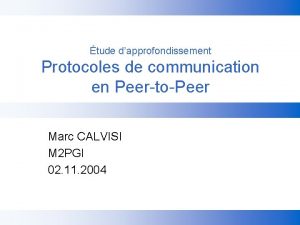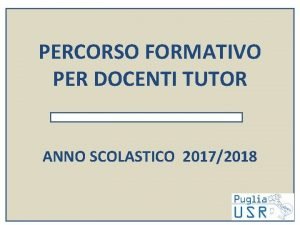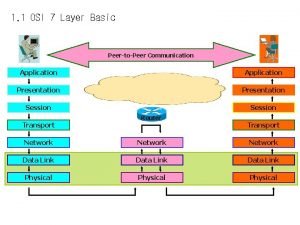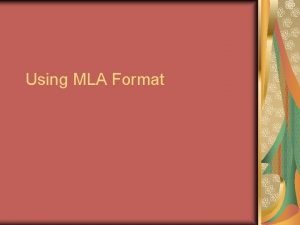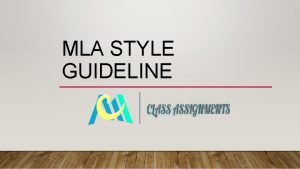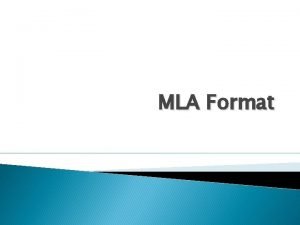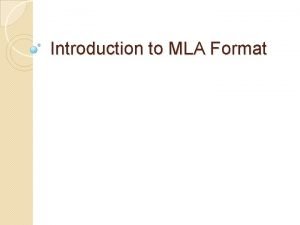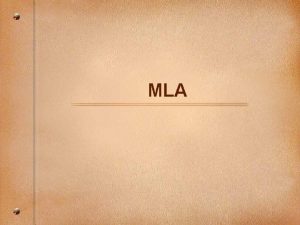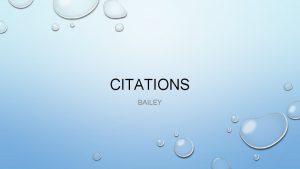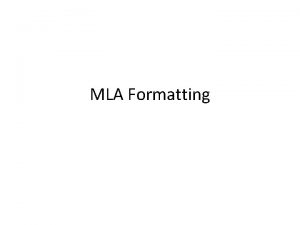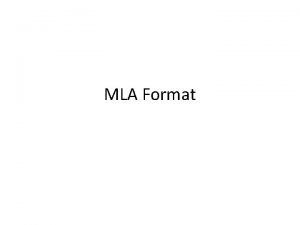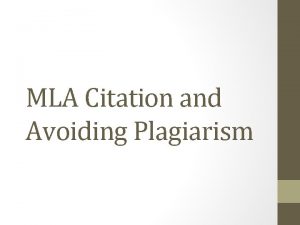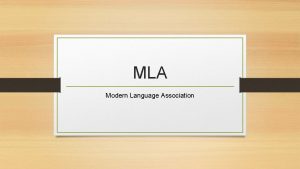Argument Peer Review Peer Review Step 1 MLA






![Peer Review Step 4: Introductory Paragraph Get out a pencil. 1. Bracket the [NARRATION] Peer Review Step 4: Introductory Paragraph Get out a pencil. 1. Bracket the [NARRATION]](https://slidetodoc.com/presentation_image/ed153863dc84747c7ef1e4729b3b2ce0/image-7.jpg)








- Slides: 15

Argument Peer Review

Peer Review Step 1: MLA Formatting Basics Use a red pen or colored pencil to mark MLA errors. 1. Is their heading correct? ○ ○ ○ Paige Mc. Nabb Mrs. Andrea Walter Honors 9 th Literature-Block # 11 September 2018 Argument Essay 2. Is the essay in Times New Roman/12 pt. font? 3. Is the essay double-spaced? 4. Does each page of the essay have a page number with their last name? ○ Ex: Mc. Nabb 2 5. Does the essay have a unique, ORIGINAL title?

Peer Review Step 2: Works Cited Page Use a red pen to mark incorrectly formatted sources. Academic Journal (Galileo): Order: 1. Author. 2. Title of source. 3. Title of container, 4. Other contributors, 5. Version, 6. Number, 7. Publisher, 8. Publication date, 9. Location. Schafer, Markus H. , et al. "Childhood (Mis)Fortune, Educational Attainment, and Adult Health: Contingent Benefits of a College Degree? . " Social Forces, vol. 91, no. 3, 01 Mar. 2013, pp. 1007 -1034. EBSCOhost, proxygsuscob. galileo. usg. edu/login? url=https: //search. ebscohost. com/login. aspx? direct=true&db=eric&AN=EJ 999648&site=edslive&scope=site. Website: Author’s Last name, First name. “Title of the Article or Individual Page. ” Title of the website, Name of the publisher, Date of publication, URL.

Works Cited Page cont. - Page number should continue onto the Works Cited page - The Works Cited page should be its OWN separate paper - Arrange sources alphabetically

Peer Review Step 3: First Read Use a purple pen to circle any use of… 1. 1 st person (I, we, us, etc. ) 2. 2 nd person (you) 3. Contractions (they’re, can’t, won’t, shouldn’t, etc. ) Follow by a very sad face.

PREFACE: As you are editing, if you find that your peer is missing something that you are supposed to be identifying, make a note in the appropriate place on the essay marking the missing element. This is crucial to the process! Your feedback is valuable. Be helpful.
![Peer Review Step 4 Introductory Paragraph Get out a pencil 1 Bracket the NARRATION Peer Review Step 4: Introductory Paragraph Get out a pencil. 1. Bracket the [NARRATION]](https://slidetodoc.com/presentation_image/ed153863dc84747c7ef1e4729b3b2ce0/image-7.jpg)
Peer Review Step 4: Introductory Paragraph Get out a pencil. 1. Bracket the [NARRATION] of the problem that defines/explains the issue. This should come before the major claim (thesis).

Peer Review Step 5: Introductory Paragraph (Thesis) Get out a pink highlighter. 1. Highlight thesis statement in pink.

Peer Review Step 6: Body (Topic Sentences) Get out an yellow highlighter. 1. Highlight each topic sentence of the paragraphs.

Peer Review Step 7: Body (Evidence) Get out a green highlighter. 1. Highlight the textual evidence in green. 2. Go back and number each piece of evidence with a circle.

Peer Review Step 8: Body (Commentary/Interpretation) Get out a blue highlighter. 1. Highlight the commentary/interpretation in blue. These are statements that further explain/illustrate/justify examples provided. This should display a ratio of 1: 3; for every quote you have used, make sure that your own voice reigns through thorough, detailed interpretations.

Peer Review Step 9: Body (Counterclaim) Get back out your pencil. 1. Underline the counterclaim twice. 2. Circle the evidence that supports the counterclaim. 3. Highlight the refutation in orange.

Peer Review Step 10: Conclusion/call to action: closing statements restating the major arguments in defense of a thesis (the claim) with a final challenge to the reader to take action. An argument has three major purposes: • To change a reader’s or listener’s point of view • To ask the reader or listener to take an action • To gain acceptance for the writer’s ideas about a problem or issue 1. Highlight the purpose in purple using guide above. 2. Highlight the extension of the claim in pink.

Peer Review Step 11: Final Steps 1. Put a question mark over words that have questionable spelling or grammar usage. 2. Put a large dot under the first word in each sentence to be sure your peer has varied sentence structure. 3. Using a brace around each paragraph (}), write the number of sentences in the margin. Word. Word. 3

Peer Review Step 12: Final Steps (Embedding Quotes) 1. Review the lead-in guide. 2. In a final read, go back through the essay and look at your peer’s lead-ins and in-text citations. 3. Write a note in the margin with an arrow pointing to the lead-in or in-text citation offering feedback. *In-text citations: Romantic poetry is characterized by the "spontaneous overflow of powerful feelings" (Wordsworth 263). When it comes to technology, we “need to be comfortable enough with technology tools and services that we can help point our patrons in the right direction, even if we aren’t intimately familiar with how the device works” (King).
 Step 1 step 2 step 3 step 4
Step 1 step 2 step 3 step 4 Ontological vs teleological
Ontological vs teleological Annotazioni sulla verifica effettuata peer to peer
Annotazioni sulla verifica effettuata peer to peer Peer-to-peer
Peer-to-peer Peer to peer transactional replication
Peer to peer transactional replication Peer to peer transactional replication
Peer to peer transactional replication Gambar topologi peer to peer
Gambar topologi peer to peer Esempio registro peer to peer compilato
Esempio registro peer to peer compilato Esempi di peer to peer compilati
Esempi di peer to peer compilati Relazione finale docente tutor compilata
Relazione finale docente tutor compilata Peer to peer l
Peer to peer l Peer to peer merupakan jenis jaringan… *
Peer to peer merupakan jenis jaringan… * Bitcoin: a peer-to-peer electronic cash system
Bitcoin: a peer-to-peer electronic cash system Features of peer to peer network and client server network
Features of peer to peer network and client server network Ambiti operativi da supportare
Ambiti operativi da supportare Peer-to-peer communication in osi model
Peer-to-peer communication in osi model



